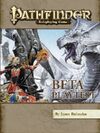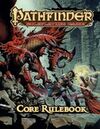In an unprecedented approach to open gaming, Paizo Publishing, LLC conducted a public playtest of their Pathfinder RPG from March 2008 to February 2009. This year-long process involved three pdf alpha releases and a beta release, published both as a pdf and softcover print version. Initial playtesting was conducted in general discussion, but beta testing was done in two-week blocks from September 2008 to late February 2009, each focusing on a different aspect of the game or chapter of the final book. By the playtest's end, over 45,000 individuals had downloaded the rules and contributed with over 100,000 posts to the discussion threads on Paizo's playtest messageboards.[1]
Design Goals[]
Jason Bulmahn, Lead Designer for Paizo's Pathfinder brand, began work on the Pathfinder Roleplaying Game in October 2007. Because of the flaws in the 3.5 rules set were now being acknowledged by both fans and the developers at Wizards of the Coast, Jason set out to develop a revised version of the existing rules available under the OGL to fix these problems and improve play without starting from scratch and negating three decades of Dungeons & Dragons history.[2] Bulmahn kept several goals in mind when creating the Pathfinder RPG to maintain a focus in the daunting task.
Improve the Game
One primary goal of designing the Pathfinder RPG was to make the game easier to play for anyone continuing with the current rules set. While the 3.5 rules set is arguably the most thorough incarnation of the world's most popular roleplaying game, it is not without its inherent design flaws. Whether it is game imbalance between classes, confusing mechanics or complicated spells, there seemed to be plenty of room for improvement without throwing everything away and starting from scratch.[2]
Add Options
Due to the various supplementary rules released since 3rd Edition was first announced, many of the core classes became relatively underpowered. Since the Pathfinder RPG would be limited to Open Gaming content, many of these options simply wouldn't be available for inclusion in the revised rules. In order to give players the incentive to use the core classes, and to promote backwards compatibility (see below) additional build options and power increases were provided to all 11 core classes.[2]
Backwards Compatibility
One of the primary inspirations for creating the Pathfinder RPG in the first place was to prevent existing gamers from finding shelves of 3rd Edition materials suddenly obsolete. To wit, the new system had to be compatible with the products released previously by Wizards of the Coast, Paizo, and any other publisher operating under the OGL. While conversion would be inevitable for almost any pre-Pathfinder RPG source, making this process as simple and seamless as possible was also a major goal of Bulmahn and the Paizo development team.[2]
Release Schedule[]
Due to the extended time over which the Pathfinder RPG playtest was designed to take place, and because the sheer amount of material to be updated was so large, several stages of release were instituted to make the process more manageable for all involved, and to make playtesting more efficient.
Alpha Release[]
Alpha Release 1 (3/18/08) - Along with the initial announcement of the Pathfinder RPG, the first installment of the Alpha release was made available on the Paizo website on March 18, 2008. This version included new rules for the four classic fantasy classes (cleric, fighter, rogue, and wizard) as well as a revised skill system, the introduction of the Combat Maneuver Bonus mechanic, and a handful of new and revised spells and feats.
Alpha Release 2 (4/22/08) - After much anticipation and discussion regarding the first Alpha release, Paizo made the second release of the Alpha playtest available for download on April 22, 2008. Combined with the original document, Release 2 included four more core classes (barbarian, druid, paladin, and sorcerer), revisions to the skill system, a new approach to the problematic Polymorph spell, and magic items. Minor revisions were also made to the grapple rules, a sign (with the simplified skill system) that the open playtest was having an impact on the development of the game.
Alpha Release 3 (5/21/08) - Release 3 included the remaining three core classes (bard, monk, and ranger) as well as NPC classes, more magic items and a guide to creating and converting monsters in the new game.
Beta Release[]
This softcover book incorporates all the material from the Alpha releases, including any changes as a result of plalytest feedback. Additionally, all material needed to run the Pathfinder RPG as a stand-alone game (without the need for previously released sources) are included in this book. It premiered at GenCon in Augugst 2008 and sold out at the convention. By mid-autumn, all print copies of the book had been purchased, leaving only the free pdf for new playtesters.
Final Release[]
The final release of the Pathfinder RPG will be a 420-page hardcover book released at GenCon 2009 in August of that year. This volume will be designed to support all future Paizo adventure paths and modules and can be used as a stand-alone replacement for the (by 2009) out-of-print core books by Wizards of the Coast, laying a foundation for OGL-based gaming for decades to come.
References[]
- ↑ Jason Bulmahn. (Februart 23, 2009). The Beta Playtest is Officially Closed, Paizo Messageboards.
- ↑ 2.0 2.1 2.2 2.3 Jason Bulmahn. (March 18, 2008). From the Lead Designer, Paizo.com.
Bold text



